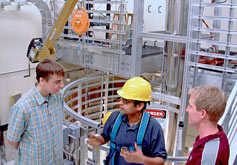
Handy Links
SLAC News Center
SLAC Today
- Subscribe
- Archives: Feb 2006-May 20, 2011
- Archives: May 23, 2011 and later
- Submit Feedback or Story Ideas
- About SLAC Today
SLAC News
Lab News
- Interactions
- Lightsources.org
- ILC NewsLine
- Int'l Science Grid This Week
- Fermilab Today
- Berkeley Lab News
- @brookhaven TODAY
- DOE Pulse
- CERN Courier
- DESY inForm
- US / LHC
SLAC Links
- Emergency
- Safety
- Policy Repository
- Site Entry Form

- Site Maps
- M & O Review
- Computing Status & Calendar
- SLAC Colloquium
- SLACspeak
- SLACspace
- SLAC Logo
- Café Menu
- Flea Market
- Web E-mail
- Marguerite Shuttle
- Discount Commuter Passes
-
Award Reporting Form
- SPIRES
- SciDoc
- Activity Groups
- Library
Stanford
Around the Bay
Sight Unseen
 Despite decades of attempts, gravitational waves continue to elude direct detection. However, one new technology could soon change that. SLAC theorists are watching closely as their experimentalist colleagues at Stanford make ready a device that will scrutinize Einstein's century-old equivalence principle, which says objects with different mass and compositions accelerate at the same speed under gravity.
Despite decades of attempts, gravitational waves continue to elude direct detection. However, one new technology could soon change that. SLAC theorists are watching closely as their experimentalist colleagues at Stanford make ready a device that will scrutinize Einstein's century-old equivalence principle, which says objects with different mass and compositions accelerate at the same speed under gravity.
The precision of the Stanford experiment will be the highest ever achieved for a test of the equivalence principle. While the Stanford researchers' immediate goal is to examine this principle, the experiment will also demonstrate technology proposed for use in the search for gravitational waves.
"Directly observing gravitational waves would revolutionize astrophysics," said SLAC graduate student Surjeet Rajendran. "They could offer a snapshot of the big bang, as well as other early universe processes."
Gravitational waves are ripples in space-time that travel at the speed of light. Current research suggests that these waves are created by massive objects, particularly by two-body systems composed of neutron stars, white dwarves or black holes, to name a few. Since the effects of gravitational waves are infinitesimal, their observation can be disrupted by almost anything—variations in atmosphere, the earth's shaking. Although several experiments have tried, none have directly observed these elusive waves. In the early stages of one gravitational wave detector, unknown signals were eventually traced back to nearby logging activity.
The hunt for direct detection of gravitational waves requires both extreme sensitivity and the ability to silence background noise. Advancements in atomic technology, which will be showcased in the Stanford experiment, offer both of these features.
The experiment's magnetically shielded vacuum pipe, which extends through a 30-foot shaft in the Varian Physics Building's basement, represents a pristine environment—"a tube of nothing," so to speak, that shields out almost all background noise. Researchers will launch millions of atoms to the top of this cylinder of nothingness. After atoms, each with slightly different mass, are pulled down the tube by gravity, measurements of their states will be conducted down to an accuracy of 15 decimal places.
Proof that this extreme precision can be achieved makes possible new types of gravitational wave detectors, which would extend the measuring capability of current methods. The collaboration that has formed between SLAC theorists and Stanford experimentalists has proposed two such detectors, one terrestrial and another satellite-based, that aim to utilize the core atomic technology of the Stanford experiment.
For the Stanford experiment, changes in trajectories and velocities will be crucial to revealing possible violations of the equivalence principle. The same is true of the proposed detectors, where the paths of atoms will potentially echo reverberations thought to be found in gravitational waves.
"The success of this experiment will be a dramatic turning point for our proposal," postdoctoral student Peter Graham said. "It will serve as a wake-up call and prove the power of this technology."
—Matt Cunningham, SLAC Today, March 24, 2008
Above image: Stanford graduate student Jason Hogan and SLAC's Surjeet Rajendran (center) and Peter Graham (right) discuss an experiment that may have vast scientific implications.